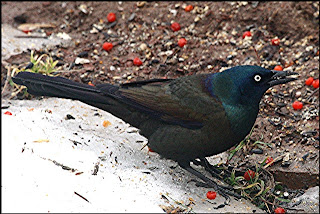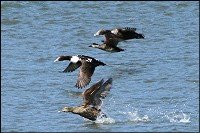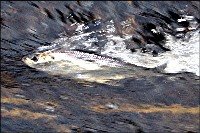Saturday, March 31, 2007
A Mixed Flock of Ducks
 While at Hazen Park today, at Oromocto, I watched a small flock of ducks fly in and land adjacent to the island in the mouth of the Oromocto River there. It was a small group comprised mainly of Mallards, but also among them I could see one male Green-winged Teal (above), a few Black Ducks and one male Wood Duck. Nearby, but not part of this group, was a male Hooded Merganser and also seven Canada Geese. An interesting sighting for one looking daily for returning ducks: all within a few minutes, all viewed from the same location.
While at Hazen Park today, at Oromocto, I watched a small flock of ducks fly in and land adjacent to the island in the mouth of the Oromocto River there. It was a small group comprised mainly of Mallards, but also among them I could see one male Green-winged Teal (above), a few Black Ducks and one male Wood Duck. Nearby, but not part of this group, was a male Hooded Merganser and also seven Canada Geese. An interesting sighting for one looking daily for returning ducks: all within a few minutes, all viewed from the same location.
Posted by
me ann my camera
at
3:14 PM
0
comments
![]()
Thursday, March 29, 2007
Sunday, March 25, 2007
Common Eider
.jpg) Yesterday we found rafts of Common Eider along the coast at Maces Bay. The Common Eider, a sea duck, is one of the largest
Yesterday we found rafts of Common Eider along the coast at Maces Bay. The Common Eider, a sea duck, is one of the largest .jpg) ducks in North America. Pictured above is a male Common Eider, flying low over the water. Mixed in with the eiders were a few Black Scoters. Above, to the right, we can easily see the size
ducks in North America. Pictured above is a male Common Eider, flying low over the water. Mixed in with the eiders were a few Black Scoters. Above, to the right, we can easily see the size .jpg) difference of these two first winter male Common Eider and the Black Scoter between them. The brown colouring of the female Common Eider can be seen in the photo above.
difference of these two first winter male Common Eider and the Black Scoter between them. The brown colouring of the female Common Eider can be seen in the photo above.
Posted by
me ann my camera
at
9:25 AM
0
comments
![]()
Saturday, March 24, 2007
female Red Crossbills
Posted by
me ann my camera
at
7:26 PM
0
comments
![]()
Grouse
.jpg) When I first saw this grouse I assumed it was a Ruffed Grouse; for this was the only species of grouse I was familiar with, but there was something different about its head; for a Ruffed Grouse has a crested head and this bird did not. I gradually realized that maybe I was looking at a Spruce Grouse and if so, this would be my very first sighting of one. A Spruce Grouse does not have a crested head.
When I first saw this grouse I assumed it was a Ruffed Grouse; for this was the only species of grouse I was familiar with, but there was something different about its head; for a Ruffed Grouse has a crested head and this bird did not. I gradually realized that maybe I was looking at a Spruce Grouse and if so, this would be my very first sighting of one. A Spruce Grouse does not have a crested head. .jpg)
After returning home and down- loading the pictures I did some research on Spruce Grouse. The Spruce Grouse is sometimes called a 'fool hen' for it does not display much alarm when encountering people and is often easily approached. When I had seen this bird I was in my car driving on the opposite side of the road. I had stopped my car directly opposite the bird and it seemed like it would have continued on across the road towards me; however an approaching car interrupted its progress and it ambled back into the wooded area beside the road. A Ruffed Grouse would have quickly disappeared. This bird is perhaps a female Spruce Grouse.
Posted by
me ann my camera
at
9:12 AM
0
comments
![]()
Friday, March 23, 2007
Chipmunk
 I noticed this little Chipmunk in our feeder area the other day and quickly reached for my camera, for although the Chipmunk
I noticed this little Chipmunk in our feeder area the other day and quickly reached for my camera, for although the Chipmunk  does not hibernate all through the winter continously it has been a long time since I have see one. This little striped back mammal, a member of the squirrel group,
does not hibernate all through the winter continously it has been a long time since I have see one. This little striped back mammal, a member of the squirrel group,  is always delightful to watch as it often fills its internal cheek pouches with seeds to bulging porportions before it scurries off to its under- ground burrow. The Chipmunk is often seen on the ground and it is easily identified by its very visible striped back.
is always delightful to watch as it often fills its internal cheek pouches with seeds to bulging porportions before it scurries off to its under- ground burrow. The Chipmunk is often seen on the ground and it is easily identified by its very visible striped back.
Posted by
me ann my camera
at
8:27 AM
0
comments
![]()
Wednesday, March 21, 2007
male Red-winged Blackbird
 Another early spring returning migrant visitor in our feeder area recently was this male Red-winged Blackbird. And although these photos were taken yesterday our first sighting of Red-winged Blackbirds this year was on March 14th.
Another early spring returning migrant visitor in our feeder area recently was this male Red-winged Blackbird. And although these photos were taken yesterday our first sighting of Red-winged Blackbirds this year was on March 14th. .jpg) Other years first spring sightings of Red-winged Blackbirds in March were on: March 22nd, 2001, on the 7th, 2002, the 23rd, 2003 and on the 12th in 2004. When feeding, the red-orange covets of this bird are often not fully visible. The small photos to the right, taken previous years, shows the distinctive 'red epaulets' of a male Red-winged Blackbird fully displayed.
Other years first spring sightings of Red-winged Blackbirds in March were on: March 22nd, 2001, on the 7th, 2002, the 23rd, 2003 and on the 12th in 2004. When feeding, the red-orange covets of this bird are often not fully visible. The small photos to the right, taken previous years, shows the distinctive 'red epaulets' of a male Red-winged Blackbird fully displayed.
You can view photos of a female Red-winged Blackbird at: http://naturetales.blogspot.com/2006/11/female-red-winged-blackbirds.html
Posted by
me ann my camera
at
6:55 AM
0
comments
![]()
Tuesday, March 20, 2007
First Goldeneye Sighting
 While surveying the flooded fields yester- day along highway 101 at Hoyt I noticed a small ice floe moving in what seemed to be a somewhat determined fashion and I quickly decided that it was not an ice floe at all but maybe a duck. Upon closer examination I discovered a male common Goldeneye a bit upstream from the highway bridge; my first duck sighting of the year!
While surveying the flooded fields yester- day along highway 101 at Hoyt I noticed a small ice floe moving in what seemed to be a somewhat determined fashion and I quickly decided that it was not an ice floe at all but maybe a duck. Upon closer examination I discovered a male common Goldeneye a bit upstream from the highway bridge; my first duck sighting of the year! 
Another posting on Common Goldeneye may be viewed at:http://naturetales.blogspot.com/2006/11/common-goldeneye.html
Posted by
me ann my camera
at
8:57 AM
0
comments
![]()
Saturday, March 17, 2007
Pine Siskin
 Today in our feeder area on this rainy, stormy day: three Pine Siskins. Also: one Song Sparrow, many American Goldfinch, several Mourning Doves, a couple of Starlings, one Hairy Woodpecker, and some Tree Sparrows.
Today in our feeder area on this rainy, stormy day: three Pine Siskins. Also: one Song Sparrow, many American Goldfinch, several Mourning Doves, a couple of Starlings, one Hairy Woodpecker, and some Tree Sparrows.
Posted by
me ann my camera
at
5:32 PM
0
comments
![]()
Wednesday, March 14, 2007
Grackles - They're Back!
.jpg) If there was ever a sure sign of spring for me; it is looking out my window and seeing Common Grackles feeding on the ground in my feeder area. Today there were six! I have been watching for them as March is the month of their return and they are usually the first sighting of returning migrants that I see. Checking back in my records I see that the earliest March sighting in our feeder area was on March 2nd in 2002. First sightings in 2001 and 2003 were towards the end of the month; not until the 22nd and 21 respectively.
If there was ever a sure sign of spring for me; it is looking out my window and seeing Common Grackles feeding on the ground in my feeder area. Today there were six! I have been watching for them as March is the month of their return and they are usually the first sighting of returning migrants that I see. Checking back in my records I see that the earliest March sighting in our feeder area was on March 2nd in 2002. First sightings in 2001 and 2003 were towards the end of the month; not until the 22nd and 21 respectively. .JPG)
For a previous posting on Grackles go to:
http://naturetales.blogspot.com/2006_06_01_archive.html
Posted by
me ann my camera
at
11:28 AM
0
comments
![]()
Sunday, March 11, 2007
Purple Finch With Yellow Neck Ring
 My two previous postings have focused on Purple Finch that have displayed partially albino features. The male Purple Finch in this photo has a different colouring variation; it has a yellow ring around its neck. This photo taken with my first digital camera, a Sony Mavica, in the early 2000's, is one of my favourite Purple Finch pictures.
My two previous postings have focused on Purple Finch that have displayed partially albino features. The male Purple Finch in this photo has a different colouring variation; it has a yellow ring around its neck. This photo taken with my first digital camera, a Sony Mavica, in the early 2000's, is one of my favourite Purple Finch pictures.
Posted by
me ann my camera
at
5:17 AM
0
comments
![]()
Saturday, March 10, 2007
Partially Albino Female Purple Finch
Posted by
me ann my camera
at
8:01 AM
0
comments
![]()
Monday, March 05, 2007
Great Horned Owl
 I don't see owls often so its always a special sighting when I do see one. This Great Horned Owl seemed to be quite curious when I spied it high up in a tree one day in March, 2002.
I don't see owls often so its always a special sighting when I do see one. This Great Horned Owl seemed to be quite curious when I spied it high up in a tree one day in March, 2002.
Posted by
me ann my camera
at
7:26 AM
0
comments
![]()
Saturday, March 03, 2007
male Red Crossbill
.jpg) Yesterday, while enroute to the city, I noticed a few small birds on the road ahead of me and as my car got closer they all flew away except this one.
Yesterday, while enroute to the city, I noticed a few small birds on the road ahead of me and as my car got closer they all flew away except this one. .jpg) Upon using my binoculars I was both surprised and pleased to see that the one remaining bird was a male Red Crossbill. I don't see this species too often as they are nomadic by nature; so this was a bit of a sighting treat. What was immediately noticable to
Upon using my binoculars I was both surprised and pleased to see that the one remaining bird was a male Red Crossbill. I don't see this species too often as they are nomadic by nature; so this was a bit of a sighting treat. What was immediately noticable to .jpg) me was the positioning of the head of the Crossbill when it was picking up gravel. It would lay its head sideways and seemed to be using its tongue to help pick up the particles from the road.
me was the positioning of the head of the Crossbill when it was picking up gravel. It would lay its head sideways and seemed to be using its tongue to help pick up the particles from the road. .jpg) Crossbills are specialist eaters of seeds of conifer cones and the unusual positioning of their crossed bills at their tips makes it easier for them to extract seeds from the cones.
Crossbills are specialist eaters of seeds of conifer cones and the unusual positioning of their crossed bills at their tips makes it easier for them to extract seeds from the cones.
To view other postings on Red Crossbills please go to:
http://naturetales.blogspot.com/2007/03/adult-female-red-crossbill.html
http://naturetales.blogspot.com/2006/11/red-crossbills.html
Posted by
me ann my camera
at
6:39 AM
0
comments
![]()
Thursday, March 01, 2007
Red Fox
.jpg) Having recently purchased an external hard drive I have been sorting and re-filing old photos and I came upon some that I had taken of a Red Fox. The first photo was taken in March, 2001. I had been driving along the road on the opposite side of the river when I spotted a fox crossing to the other side. This is my first picture ever taken of a fox.
Having recently purchased an external hard drive I have been sorting and re-filing old photos and I came upon some that I had taken of a Red Fox. The first photo was taken in March, 2001. I had been driving along the road on the opposite side of the river when I spotted a fox crossing to the other side. This is my first picture ever taken of a fox. The second photo is a much better view and this was taken last April, in 2006. In this photo the fox was trotting along the edge of the woods carrying something in its mouth. As the fox's young are born in April; I wonder if this fox was possibly carrying a young kit in it's mouth?
The second photo is a much better view and this was taken last April, in 2006. In this photo the fox was trotting along the edge of the woods carrying something in its mouth. As the fox's young are born in April; I wonder if this fox was possibly carrying a young kit in it's mouth?
Posted by
me ann my camera
at
7:07 AM
0
comments
![]()







.JPG)
.JPG)













